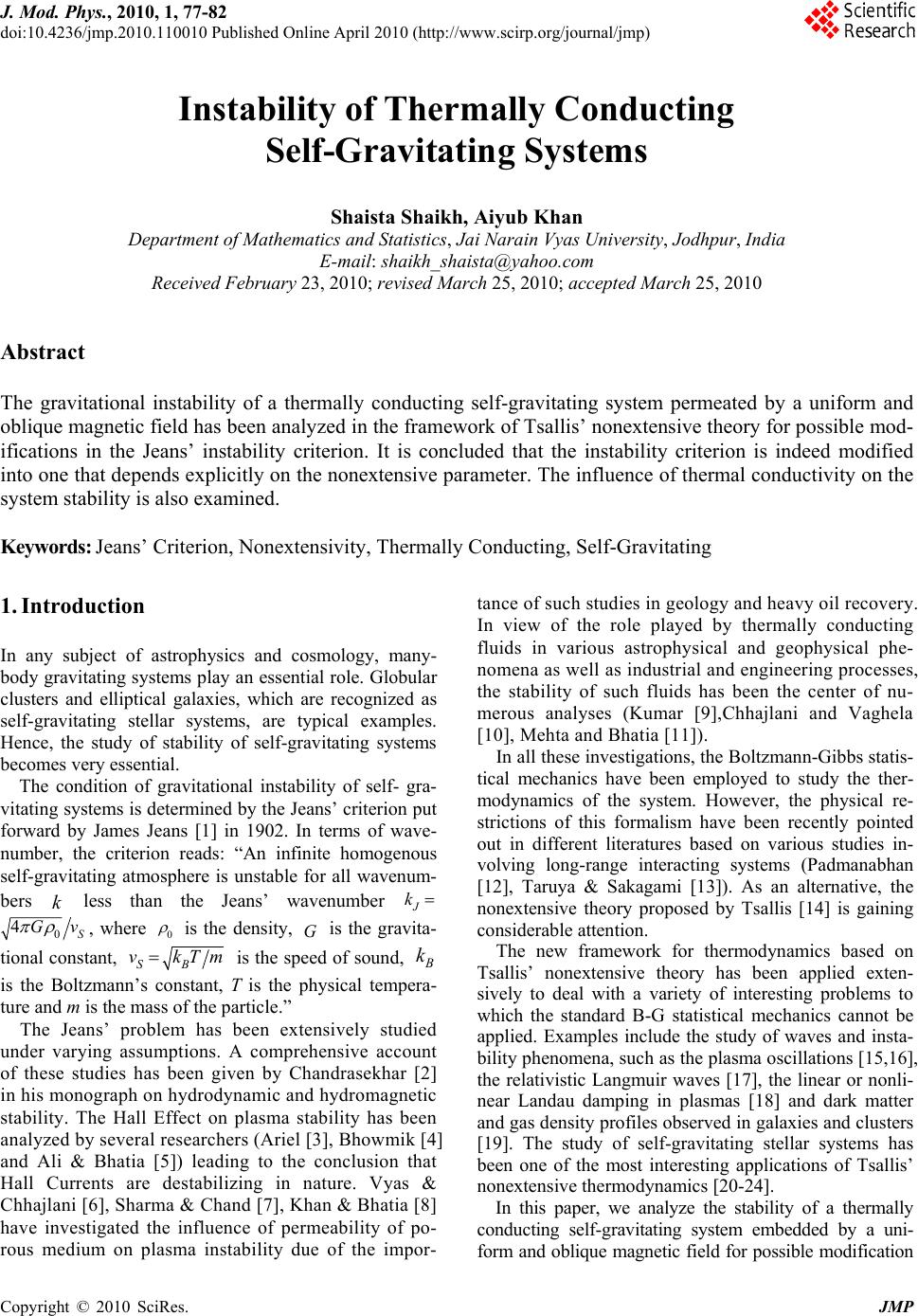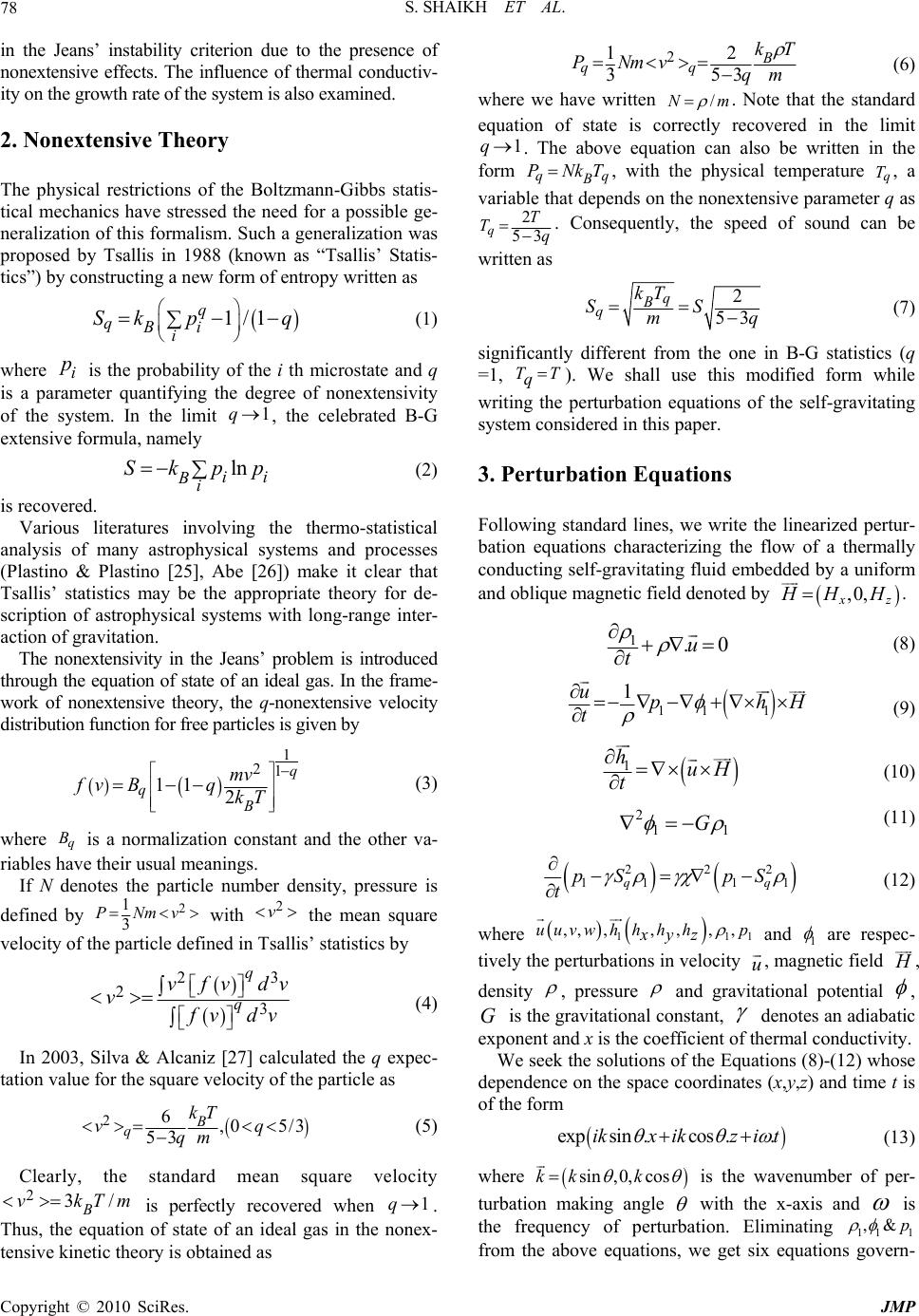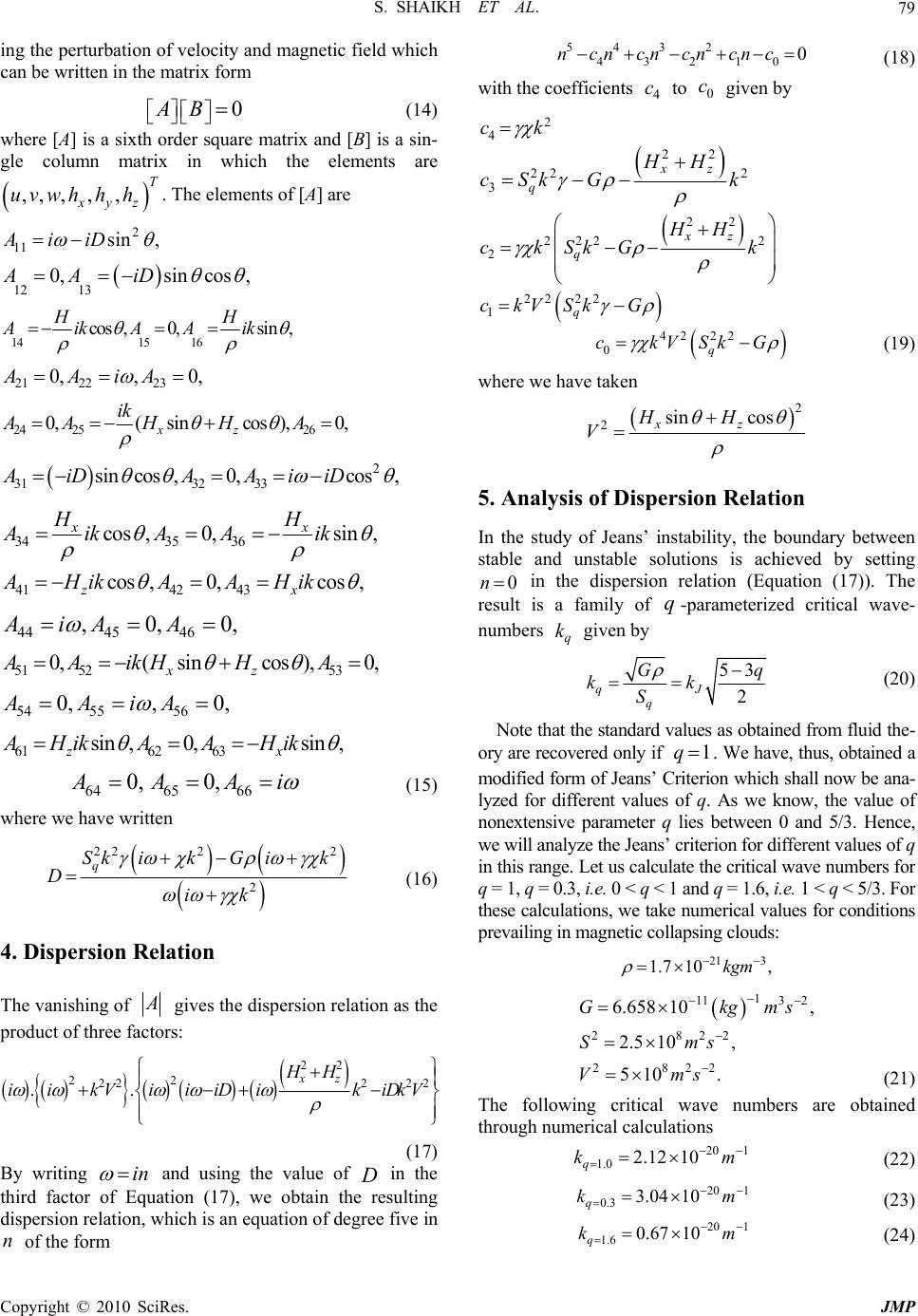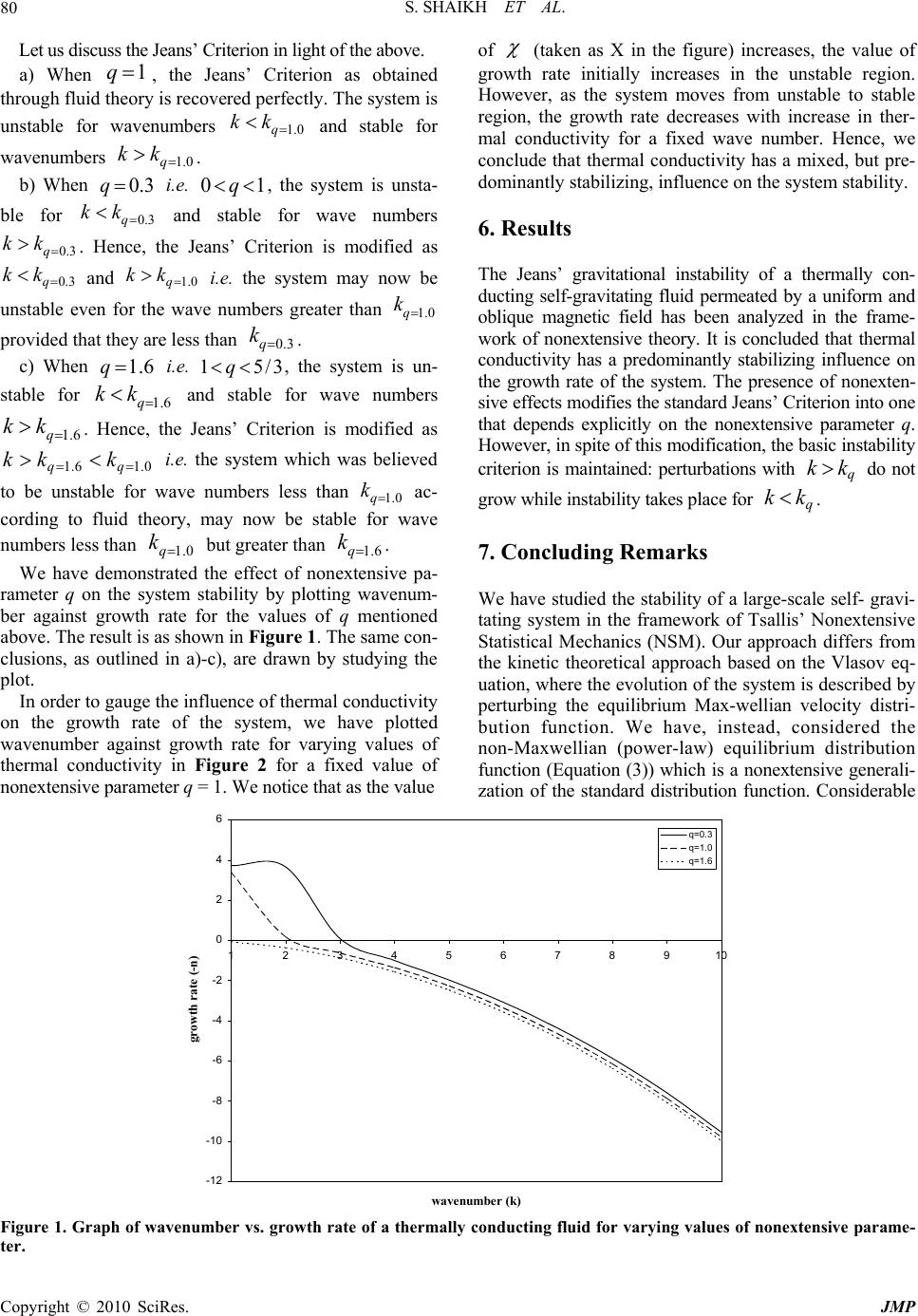Paper Menu >>
Journal Menu >>
 J. Mod. Phys., 2010, 1, 77-82 doi:10.4236/jmp.2010.110010 Published Online April 2010 (http://www.scirp.org/journal/jmp) Copyright © 2010 SciRes. JMP Instability of Thermally Conducting Self-Gravitating Systems Shaista Shaikh, Aiyub Khan Department of Mathematics and Statistics, Jai Narain Vyas University, Jodhpur, India E-mail: shaikh_shaista@yahoo.com Received February 23, 2010; r evis ed M arch 25, 2010; accepted March 25, 2010 Abstract The gravitational instability of a thermally conducting self-gravitating system permeated by a uniform and oblique magnetic field has been analyzed in the framework of Tsallis’ nonextensive theory for possible mod- ifications in the Jeans’ instability criterion. It is concluded that the instability criterion is indeed modified into one that depends explicitly on the nonextensive parameter. The influence of thermal conductivity on the system stability is also examined. Keywords: Jeans’ Criterion, Nonextensivity, Thermally Conducting, Self-Gravitating 1. Introduction In any subject of astrophysics and cosmology, many- body gravitating systems play an essential role. Globular clusters and elliptical galaxies, which are recognized as self-gravitating stellar systems, are typical examples. Hence, the study of stability of self-gravitating systems becomes very essential. The condition of gravitational instability of self- gra- vitating systems is determined by the Jean s’ criterion put forward by James Jeans [1] in 1902. In terms of wave- number, the criterion reads: “An infinite homogenous self-gravitating atmosphere is unstable for all wavenum- bers k less than the Jeans’ wavenumber J k 0 4S Gv , where 0 is the density, G is the gravita- tional constant, B S vkTm is the speed of sound, B k is the Boltzmann’s constant, T is the physical tempera- ture and m is the mass of the particle.” The Jeans’ problem has been extensively studied under varying assumptions. A comprehensive account of these studies has been given by Chandrasekhar [2] in his monograph on hydrodynamic and hydromagnetic stability. The Hall Effect on plasma stability has been analyzed by several researchers (Ariel [3], Bhowmik [4] and Ali & Bhatia [5]) leading to the conclusion that Hall Currents are destabilizing in nature. Vyas & Chhajlani [6], Sharma & Chand [7], Khan & Bhatia [8 ] have investigated the influence of permeability of po- rous medium on plasma instability due of the impor- tance of such studies in geology and heavy oil recovery. In view of the role played by thermally conducting fluids in various astrophysical and geophysical phe- nomena as well as industrial and engineering processes, the stability of such fluids has been the center of nu- merous analyses (Kumar [9],Chhajlani and Vaghela [10], Mehta and Bhatia [11]). In all these investigations, the Bo ltzmann-Gibbs statis- tical mechanics have been employed to study the ther- modynamics of the system. However, the physical re- strictions of this formalism have been recently pointed out in different literatures based on various studies in- volving long-range interacting systems (Padmanabhan [12], Taruya & Sakagami [13]). As an alternative, the nonextensive theory proposed by Tsallis [14] is gaining considerable attention. The new framework for thermodynamics based on Tsallis’ nonextensive theory has been applied exten- sively to deal with a variety of interesting problems to which the standard B-G statistical mechanics cannot be applied. Examples include the study of waves and insta- bility phenomena, such as th e plasma oscillations [15,16], the relativistic Langmuir waves [17], the linear or nonli- near Landau damping in plasmas [18] and dark matter and gas density profiles observed in galaxies and clusters [19]. The study of self-gravitating stellar systems has been one of the most interesting applications of Tsallis’ nonextensive thermodynamics [20-24]. In this paper, we analyze the stability of a thermally conducting self-gravitating system embedded by a uni- form and oblique magnetic field for possible modification  S. SHAIKH ET AL. Copyright © 2010 SciRes. JMP 78 in the Jeans’ instability criterion due to the presence of nonextensive effects. The influence of thermal conductiv- ity on the growth rate of the system is also examined. 2. Nonextensive Theory The physical restrictions of the Boltzmann-Gibbs statis- tical mechanics have stressed the need for a possible ge- neralization of this formalism. Such a generalization was proposed by Tsallis in 1988 (known as “Tsallis’ Statis- tics”) by constructing a new form of entropy written as 1/1 q qi Bi Sk pq (1) where i p is the probability of the i th microstate and q is a parameter quantifying the degree of nonextensivity of the system. In the limit 1q, the celebrated B-G extensive formula, namely ln ii Bi Skpp (2) is recovered. Various literatures involving the thermo-statistical analysis of many astrophysical systems and processes (Plastino & Plastino [25], Abe [26]) make it clear that Tsallis’ statistics may be the appropriate theory for de- scription of astrophysical systems with long-range inter- action of gra vitati on . The nonextensivity in the Jeans’ problem is introduced through the equation of state of an ideal gas. In the frame- work of nonextensive theory, the q-nonextensive velocity distribution function for free particles is given by 1 21 11 2 q qB mv fvBq kT (3) where q B is a normalization constant and the other va- riables have their usual meanings. If N denotes the particle number density, pressure is defined by 2 1 3 PNmv with 2 v the mean square velocity of the particle defined in Tsallis’ statistics by 23 23 q q vfvdv v f vdv (4) In 2003, Silva & Alcaniz [27] calculated the q expec- tation value for the square velocity of the particle as 26,0 5/3 53 B qkT vq qm (5) Clearly, the standard mean square velocity 23/ B vkTm is perfectly recovered when 1q. Thus, the equation of state of an ideal gas in the nonex- tensive kinetic theory is obtained as 2 12 353 B qq kT PNmv qm (6) where we have written /Nm . Note that the standard equation of state is correctly recovered in the limit 1q. The above equation can also be written in the form qq B PNkT , with the physical temperature q T, a variable that depends on the nonextensive parameter q as 2 53 qT Tq . Consequently, the speed of sound can be written as 2 53 q B qkT SS mq (7) significantly different from the one in B-G statistics (q =1, TT q ). We shall use this modified form while writing the perturbation equations of the self-gravitating system considered in this paper. 3. Perturbation Equations Following standard lines, we write the linearized pertur- bation equations characterizing the flow of a thermally conducting self-gravitating fluid embedded by a uniform and oblique magnetic field denoted by ,0, x z HH H . 1.0u t (8) 11 1 1u p hH t (9) 1 huH t (10) 211 G (11) 222 11 11qq pS pS t (12) where 111 ,,,,,, ,uuvwh hhhp xyz and 1 are respec- tively the perturbations in velocity u , magnetic field H , density , pressure and gravitational potential , G is the gravitational constant, denotes an adiabatic exponent and x is the coefficient of thermal conductivity. We seek the solutions of the Equations (8)-(12) whose dependence on the space coordinates (x,y,z) and time t is of the form expsin.cos ..ikx ikzit (13) where sin ,0, coskk k is the wavenumber of per- turbation making angle with the x-axis and is the frequency of perturbation. Eliminating 11 1 ,&p from the above equations, we get six equations govern-  S. SHAIKH ET AL. Copyright © 2010 SciRes. JMP 79 ing the perturbation of velocity and magnetic field which can be written in the matrix form 0AB (14) where [A] is a sixth order square matrix and [B] is a sin- gle column matrix in which the elements are ,, ,,,T xyz uvwh hh. The elements of [A] are 2 11 sin ,AiiD 12 13 0,sincos,AAiD 1415 16 cos ,0,sin , z z HH AikAAik 21 2223 0,, 0,AAiA 24 2526 0,(sincos ),0, xz ik AAHH A 2 3132 33 sincos ,0,cos,AiD AAiiD 3435 36 4142 43 cos ,0,sin , cos,0,cos, xx zx HH AikAA ik AHikA AHik 4445 46 ,0,0,AiA A 51 5253 0,(sincos ),0, xz AAikHH A 54 5556 0,, 0,AAiA 6162 63 sin, 0,sin, zx AHikAA Hik 64 0,A65 66 0, A Ai (15) where we have written 22 22 2 q SkikGik Dik (16) 4. Dispersion Relation The vanishing of A gives the dispersion relation as the product of three factors: 22 22 222 22 .. xz HH iik ViiiDikiDk V (17) By writing in and using the value of D in the third factor of Equation (17), we obtain the resulting dispersion relation, which is an equation of degree five in n of the form 5432 43210 0ncncncncnc (18) with the coefficients 4 c to 0 c given by 2 4 ck 22 22 2 3 xz q HH cSkGk 22 222 2 2 xz q HH ckSkG k 22 22 1q ckVSk G 42 22 0q ckVSkG (19) where we have taken 2 2sin cos xz HH V 5. Analysis of Dispersion Relation In the study of Jeans’ instability, the boundary between stable and unstable solutions is achieved by setting 0n in the dispersion relation (Equation (17)). The result is a family of q-parameterized critical wave- numbers q k given by 53 2 qJ q Gq kk S (20) Note that the standard values as obtained fro m fluid the- ory are recovered only if 1q . We have, thus, obtained a modified form of Jeans’ Criterion which shall now be ana- lyzed for different values of q. As we know, the value of nonextensive parameter q lies between 0 and 5/3. Hence, we will analyze the Jeans’ criterion for different values of q in this range. Let us calculate the cr itic al wav e nu mbers for q = 1, q = 0.3, i.e. 0 < q < 1 and q = 1.6, i.e. 1 < q < 5/3. For these calculations, we take nu merical values for conditions prevailing in magnetic collapsing clouds: 21 3 1.7 10,kgm 1 113 2 2 822 2 822 6.65810, 2.5 10, 510. Gkgms Sms Vms (21) The following critical wave numbers are obtained through numerical calculations 20 1 1.0 2.1210 q km (22) 20 1 0.3 3.0410 q km (23) 20 1 1.6 0.6710 q km (24)  S. SHAIKH ET AL. Copyright © 2010 SciRes. JMP 80 Let us discuss the Jeans’ Criterion in light of the above. a) When 1q, the Jeans’ Criterion as obtained through fluid theory is recovered perfectly. The system is unstable for wavenumbers 1.0q kk and stable for wavenumbers 1.0q kk . b) When 0.3q i.e. 01q , the system is unsta- ble for 0.3q kk and stable for wave numbers 0.3q kk . Hence, the Jeans’ Criterion is modified as 0.3q kk and 1.0q kk i.e. the system may now be unstable even for the wave numbers greater than 1.0q k provided that they are less than 0.3q k. c) When 1.6q i.e. 15/3q , the system is un- stable for 1.6q kk and stable for wave numbers 1.6q kk . Hence, the Jeans’ Criterion is modified as 1.6 1.0qq kk k i.e. the system which was believed to be unstable for wave numbers less than 1.0q k ac- cording to fluid theory, may now be stable for wave numbers less than 1.0q k but greater than 1.6q k. We have demonstrated the effect of nonextensive pa- rameter q on the system stability by plotting wavenum- ber against growth rate for the values of q mentioned above. The result is as shown in Figure 1. The same con- clusions, as outlined in a)-c), are drawn by studying the plot. In order to gauge the influence of thermal conductivity on the growth rate of the system, we have plotted wavenumber against growth rate for varying values of thermal conductivity in Figure 2 for a fixed value of nonextensive parame ter q = 1. We notice that as the value of (taken as X in the figure) increases, the value of growth rate initially increases in the unstable region. However, as the system moves from unstable to stable region, the growth rate decreases with increase in ther- mal conductivity for a fixed wave number. Hence, we conclude that thermal conductivity has a mixed, but pre- dominantly stabilizing, influence on the system stability. 6. Results The Jeans’ gravitational instability of a thermally con- ducting self-gravitating fluid permeated by a uniform and oblique magnetic field has been analyzed in the frame- work of nonextensive theory. It is concluded that thermal conductivity has a predominantly stabilizing influence on the growth rate of the system. The presence of nonexten- sive effects modifies the standard Jeans’ Criterion into one that depends explicitly on the nonextensive parameter q. However, in spite of this modification, the basic inst abi lity criterion is maintained: perturbations with q kk do not grow while instability takes place for q kk. 7. Concluding Remarks We have studied the stability of a large-scale self- gravi- tating system in the framework of Tsallis’ Nonextensi ve Statistical Mechanics (NSM). Our approach differs from the kinetic theoretical approach based on the Vlasov eq- uation, where the evolution of the system is described by perturbing the equilibrium Max-wellian velocity distri- bution function. We have, instead, considered the non-Maxwellian (power-law) equilibrium distribution function (Equation (3)) which is a nonextensive generali- zation of the standard distribution function. Considerable -12 -10 -8 -6 -4 -2 0 2 4 6 12345678910 wavenumber (k) growth rate (-n) q=0.3 q=1.0 q=1.6 Figure 1. Graph of wavenumber vs. growth rate of a thermally conducting fluid for varying values of nonextensive parame- ter.  S. SHAIKH ET AL. Copyright © 2010 SciRes. JMP 81 -60 -50 -40 -30 -20 -10 0 10 20 12345678910 wavenumber (k) growth rate (-n) X= 0 .1 X= 1 .0 X= 2 .0 X= 5 .0 Figure 2. Graph of wavenumber vs. growth rate of a thermally conducting fluid for varying values of coefficient of thermal conductivity. amount of experimental evidence supports the employ- ment of such a distribution (e.g. Liu et al. [28]), clearly indicating that the standarsd Maxwellian velocity distri- bution might provide only a very crude description of the velocity distribution for a self-gravitating gas, or gener- ally for any system endowed with long range interactions. Infact, a well determined criterion for gravitational insta- bility is not a privilege of the exponential velocity dis- tribution function, but is shared by an entire family of power-law functions (named q-exponentials) which in- cludes the standard Jeans’ result for the Maxwellian dis- tribution as a limiting case (q = 1). This being said, it must also be stressed that all nonextensive systems need not require the Tsallis’ statistics to understand their be- haviors (Cohen [29]). In the light of present understand- ing, it is still unclear which class of nonextensive sys- tems requires Tsallis’ statistics for its statistical descrip- tion, mainly due to the fact that the physical meaning of the nonextensive parameter q is yet to be settled. Al- though some progress in this regard is being made (Du [22,23]), the Nonextensive Statistical Mechanics remains open to further verification and deeper understanding. Further Reading: Interested readers may refer to simi- lar works by the authors [30,31,32] on the instability of thermally conducting self-gravitating systems in the framewor k o f n o nextensive s t at ist ics. Acknowledgements: This work was carried out as part of a major research project (F. No. 36-103/2008 (SR)) awarded by University Grants Commission (UGC), India to the one of the authors, Aiyub Khan. The financial as- sistance from UGC is gratefully acknowledged. The au- thors are also grateful to the reviewer for useful sugges- tions, which have helped in improving the overall pres- entation and quality of the paper. 8. References [1] J. H. Jeans, “The Stability of Spherical Nebulae,” Phi- losophical Transactions of the Royal Society of London, A 199, 1902, pp. 1-53. [2] S. Chandrasekhar, “Hydrodynamics & Hydromagnetic Stability,” Clarendron Press, Oxford, 1961. [3] P. D. Ariel, “The Character of Equilibrium of an Inviscid Infinitely Conducting Fluid of Variable Density in the Presence of a Horizontal Magnetic Field with Hall-Ur- rent,” Journal of Plasma Physics, Vol. 4, 1970, pp. 523-530. [4] G. Bhowmik, “Rayleigh Taylor Instability of a Viscous Hall Plasma with Magnetic Field,” Journal of Plasma Physics, Vol. 7, 1972, pp. 117-132. [5] A. Ali and P. K. Bhatia, “Magnetic Resistivity and Hall Currents Effects on the Stability of a Self-Gravitating Plasma of Varying Density in Variable Magnetic Field,” Astrophysics and Space Science, Vol. 201, 1993, pp. 15-27. [6] M. K. Vyas and R. K. Chhajlani, “Gravitational Instabil- ity of a thermally-conducting Plasma Flowing through a Porous Medium in the Presence of Suspended Particles,” Astrophysics and Space Science, Vol. 149, 1988, pp. 323-342. [7] R. C. Sharma and T. Chand, “Gravitational Instability for Some Astrophysical Systems,” Astrophysics and Space Science, Vol. 183, 1991, pp. 215-224. [8] A. Khan and P. K. Bhatia, “Stability of Two Superposed Viscoelastic Fluid in a Horizontal Magnetic Field,” In- dian Journal of Pure and Applied Mathematics, Vol. 32, 2001, pp. 98-108. [9] S. S. Kumar, “On Gravitational Instability, III,” Publica- tions of the Astronomical Society of Japan, Vol. 13, 1961,  S. SHAIKH ET AL. Copyright © 2010 SciRes. JMP 82 pp. 121-124. [10] R. H. Chhajla ni and D. S. Vaghela, “Magnetogravitational Stability of Self-Gravitating Plasma with Thermal Conduc- tion and Finite Larmor Radius through Porous Medium,” Astrophysics and Space Science, Vol. 134, 1987, pp. 301- 315. [11] V. Mehta and P. K. Bhatia, “Gravitational Instability of a Rotating Viscous Thermally Conducting plasma,” Con- tributions to Plasma Physics, Vol. 29, 1989, pp. 617-626. [12] T. Padmanabhan, “Statistical Mechanics of Gravitating Systems,” Physics Reports, Vol. 188, 1990, pp. 285-362. [13] A. Taruya and M. Sak aga mi, “Thermodynamic Properties of Stellar Polytrope,” Physica A, Vol. 318, 2003, pp. 387-413. [14] C. Tsallis, “Possible Generalization of Boltzmann-Gibbs Statistics,” Journal of Statistical Physics, Vol. 52, 1988, pp. 479-487. [15] R. Silva, J. A. Alcaniz and J. A. S. Lima, “Constraining Nonextensive Statistics with Plasma Oscillation Data,” Physica A, Vol. 356, 2005, pp. 509-516. [16] S. Shaikh, A. Khan and P. K. Bhatia, “Jeans’ Gravita- tional Instability of a Thermally Conducting, Unbounded, Partially Ionized Plasma,” Zeitschrift für Naturforschung, Vol. 61, 2006, pp. 275-280. [17] V. Munoz, “A Nonextensive Statistics Approach for Langmuir Waves in Relativistic Plasmas,” Nonlinear Processes in Geophysics, Vol. 13, 2006, pp. 237-241. [18] F. Valentini, “Nonlinear Landau Damping in Nonex- ten-sive Statistics,” Physics of Plasmas, Vol. 12, 2005, pp. 1-7. [19] M. P. Leubner, “Nonextensive Theory of Dark Matter and Gas Density Profiles,” The Astrophysical Journal, Vol. 632, 2005, pp. L1-L4. [20] J. A. S. Lima, R. Silva and J. Santos, “Jeans’ Gravita- tional Instability and Nonextensive Kinetic Theory,” As- tronomy and Astrophysics, Vol. 396, 2002, pp. 309-313. [21] J. L. Du, “Jeans’ Criterion and Nonextensive Velocity Distribution Function in Kinetic Theory,” Physics Letters A, Vol. 320, 2004, pp. 347-351. [22] J. L. Du, “Nonextensivity in Nonequilibrium Plasma Systems with Coulombian Long-Range Interactions,” Physics Letters A, Vol. 329, 2004, pp. 262-267. [23] J. L. Du, “What Does the Nonextensive Parameter Stand for in Self-Gravitating Systems?” Astrophysics and Space Science, Vol. 305, 2006, pp. 247-251. [24] J. L. Du, “Nonextensivity and the Power-Law Distribu- tions for the Systems with Self-Gravitating Long-Range Interactions,” Astrophysics and Space Science, Vol. 312, 2007, pp. 47-55. [25] A. Plastino and A. R. Plastino, “Stellar Polytropes and Tsallis’ Entropy,” Physics Letters A, Vol. 174, 1993, pp. 384-386. [26] S. Abe, “Thermodynamic Limit of a Classical gas in Nonextensive Statistical Mechanics: Negative Specific Heat and Polytropism,” Physics Letters A, Vol. 263, 1999, pp. 424-429. [27] R. Silva and J. S. Alcaniz, “Negative Heat Capacity and Non-Extensive Kinetic Theory,” Physics Letters A, Vol. 313, 2003, pp. 393-396. [28] J. M. Liu, J. S. D. Groot, J. P. Matte, T. W. Johnston and R. P. Drake, “Measurements of Inverse Bremsstrahlung Absorption and Non-Maxwellian Electron Velocity Dis- tributions,” Physical Review Letters, Vol. 72, 1994, pp. 2717-2720. [29] E. G. D. Cohen, “Statistics and Dynamics,” Physica A, Vol. 305, 2002, pp. 19-26. [30] S. Shaikh, A. Khan and P. K. Bhatia, “Stability of Ther- mally Conducting Plasma in a Variable Magnetic Field,” Astrophysics and Space Science, Vol. 312, 2007, pp. 35-40. [31] S. Shaikh, A. Khan and P. K. Bhatia, “Thermally Con- ducting Partially Ionized Plasma in a Variable Magnetic Field,” Contributions to Plasma Physics, Vol. 47, No. 3, 2007, pp. 147-156. [32] S. Shaikh, A. Khan and P. K. Bhatia, “Jeans’ Gravita- tional Instability of a Thermally Conducting Plasma,” Physics Letters A, Vol. 372, 2008, pp. 1451-1457. |

